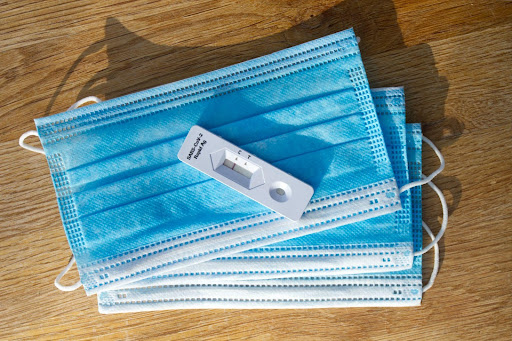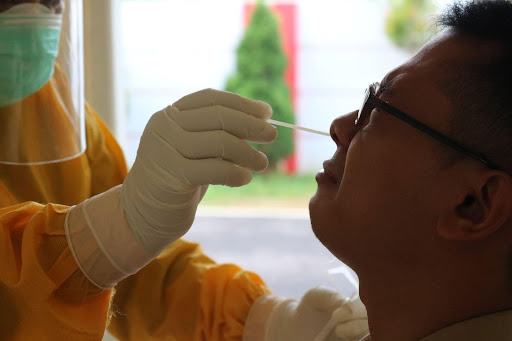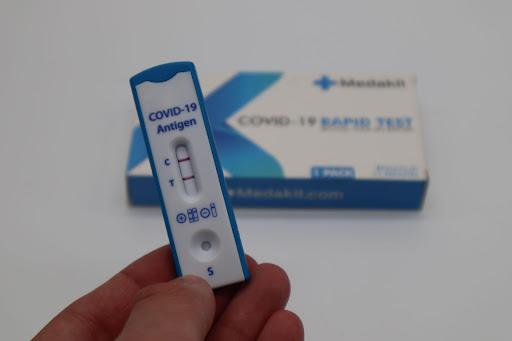Even if COVID isn’t considered as dangerous as it once was, it certainly doesn’t take away that people worldwide need to play it safe, mind their safety and hygiene, and take a test when symptoms are showing. At the same time, you could visit your local testing facility, so people want to personally opt for a less stressful experience by taking care of everything at home.
While at-home and testing facility tests will each have their perks, it’s essential to try out both to conclude what you may prefer the most. So, how do you take an at-home COVID test? Are they safe? Are they accurate? All of these questions will be answered in this post!

What is a Self-Test or At-Home Test?
A self-test is a test that is taken at home. It is typically used to check for health problems. Fortunately, at-home testing kits for COVID-19 can be readily available at your local drug store or medicine aisle in grocery stores. But they can be available for free as well for some households. Many self-tests are available on the market, but some are not very accurate and can lead to false positives or false negatives.
While this has been known, self-tests are still good indicators of determining whether or not you have Corona. If you need an immediate answer, an at-home test can be a good decision. But keep in mind that visiting your local doctor’s office or a COVID-19 testing facility will be better and more accurate than a store-bought test.
Related: Moral Injury in Health Care Workers
When You Should Take an At-Home Covid Test
Ideally, you’ll want to test yourself the very moment that you have COVID-19 symptoms. You should test yourself immediately if you can. Even if you’ve recently been in contact with someone who recently had COVID-19 or is currently being exposed to COVID-19, you’ll need to take a rapid at-home covid test. Even if you tested negative after being exposed, you’re going to want to play it safe by giving yourself another test within one to two days after the first rapid at-home test.
Also, if you’re going to be attending some gathering, whether it be social (such as parties), meals, or even something like a museum visit, you should test yourself before and after the event to ensure that you didn’t catch COVID. You should also immediately test yourself before a gathering (and close to an event) if you’re visiting individuals who are more at risk of Corona.
This can include individuals who may be at risk of severe diseases, immunocompromised, and older adults. Plus, you should look into getting tested before and after if you plan to be around anyone who doesn’t have up-to-date COVID-19 vaccinations or children who have yet to get their vaccinations either. While there may be a lot of instances on why you may need to get an at-home covid testing kit, it’s worth it in the end.

How Accurate are At-Home Rapid Tests?
The at-home rapid covid tests can provide people with results within a few minutes. It’s great as there isn’t a need to go out, find a testing facility, and wait for the results there. Instead, you can quickly and efficiently get this all done in the comfort of your own home without the need to leave.
The at-home rapid test may have its perks of comfort and convenience, but they aren’t as accurate as of the gold standard PCR tests that you can get as testing facilities. Since rapid at-home tests are antigen-based tests, they are at higher risk of becoming a false positive or false negative. This means that this type of test will be less reliable in indicating whether or not you have COVID-19.
Related: The Mind-Body Connection
How to Get an At-Home Covid Test
If you’re wondering how you can buy yourself an at-home Covid test, you’re in luck. You don’t need to navigate a good team of medical directors at testing facilities. While tests have been difficult to come by earlier in the pandemic, that isn’t the case any longer. There are many ways to get an at-home Covid test. You can go to your local pharmacy, use an online eCommerce platform to buy a pack, or even make the purchase at your local grocery or convenience store.
Since rapid at-home Covid tests are selling quite often, it’s great that there is an ease in finding them. You won’t want to worry about not spotting them as they are increasingly becoming more widely available in various establishments.
Looking for personalized care that you just can’t get at a hospital? Then you’re in luck! Contact OptiMed Hospitalist today!
How to Use the Self-Test
While you could opt into helpful clinics, testing facilities, or other medical professional services, a self-test is pretty straightforward. While COVID-19 testing facilities will do all the work for you, it’s completely understandable if you feel a little confused when you buy an at-home test. The self-test has several components, but once you read the direction, it becomes clearer what it all needs to be used for. The self-tests can be done by teenagers and adults and conducted by an adult for children 12 and under. Here are the steps you’ll need to take when conducting a self-COVID test in your home.
1) Prepare your test area by scouring the surface where you’ll place the test at
2) Don’t eat or drink 30 minutes before the test
3) Sanitize your hands before opening up the test kit
4) Check all the contents to ensure that everything is there
5) Set up your test, placing the test step out of the sealed bag and onto a flat surface. You’re also going to want to place the tube in the extraction tube holder, per the instructions on the box. Make sure to carefully open the liquid and place it gently into the extraction tube.
6) Blow your nose and wash your hands once more
7) Open up the cotton swab from the packaging and gently place it either in your mouth or nose (based on the instructions of the rapid test)
8) Afterwards, you’ll want to process the swab sample by placing it into the extraction tube for 15 seconds. Afterward, press the cap down tight to avoid any leaks
9) You’ll want to squeeze the extraction tube into the circle on the test strip kit
10) You may have to wait anywhere from 15 to 30 minutes to receive your results.
While these steps can be pretty lengthy, it’s vital to ensure it’s all done correctly, as this can boost your chances of having accurate results.
Related: What is Hospitalist?

What do the Results Mean?
It’s essential to try and understand your Covid-19 test results. While the instruction booklet that comes with each rapid at-home antigen test will be included, it never hurts to look elsewhere to have a better understanding of the self-test covid results. So here’s what you need to know:
- Positive COVID-19 results mean that two colors lines will appear. While there is a chance of false- positives (or false negatives), it’s up to your discretion to retake the test.
- Negative COVID-19 results mean that there aren’t two colored lines. Instead, you’ll find one colored line that appears on the C (control) region. No line will appear on the results’ T (test) region.
- Invalid Result will mean that either no line shows up on the test results or one line will show up on the T (test) section of the Result. After 15 minutes, if it still shows invalid, it’s strongly recommended to take another test.
Since it can be considered fairly frustrating if your self-test results aren’t showing up the way you like, just make sure that you’re open to visiting a medical facility so you can get tested there.
Needing personalized medical care? Then check out the Locations & Services of OptiMed Hospitalist!
Conclusion
Overall, since COVID-19 is still among us and safety precautions need to be taken, having some at-home rapid tests on hand can be one of the best ways to play it safe. In addition, it allows you to have your self-tested at home if you do have Corona, which lowers the chances of others getting contaminated. The combination of rapid results, affordable price, and the convenience of having a rapid at-home test be done anywhere are why it’s so favored.
